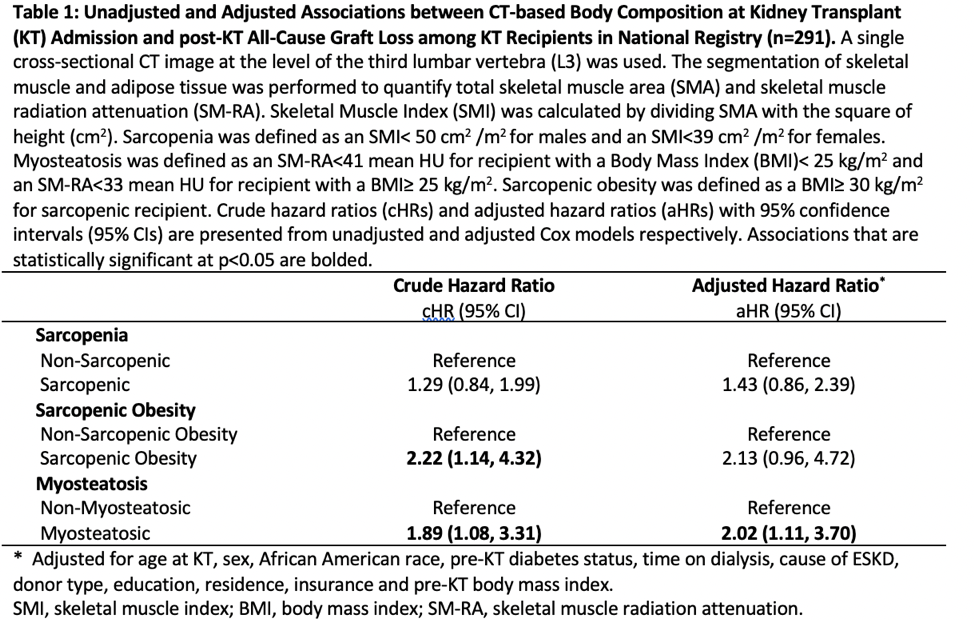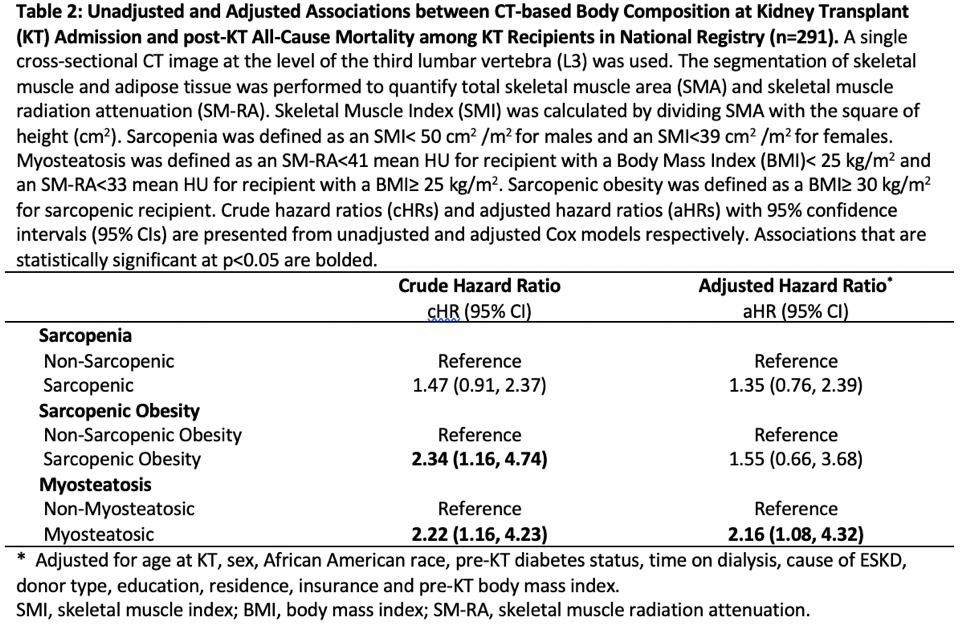Association Between CT Measurements of Body Composition Before Kidney Transplantation and Post-Transplantation Outcomes
Johns Hopkins University, Baltimore, MD
Meeting: 2022 American Transplant Congress
Abstract number: 1783
Keywords: Graft failure, Kidney transplantation, Mortality, Radiologic assessment
Topic: Clinical Science » Organ Inclusive » 68 - Deceased Donor Management and Intervention Research
Session Information
Session Name: Deceased Donor Management and Intervention Research
Session Type: Poster Abstract
Date: Tuesday, June 7, 2022
Session Time: 7:00pm-8:00pm
 Presentation Time: 7:00pm-8:00pm
Presentation Time: 7:00pm-8:00pm
Location: Hynes Halls C & D
Session Information
Session Time: 7:00pm-8:00pm
 Presentation Time: 7:00pm-8:00pm
Presentation Time: 7:00pm-8:00pm
Location: Hynes Hall C
*Purpose: Body composition has been found to be associated with the risks of post-kidney transplantation (KT) outcomes. However, it is unclear which pre-KT computed tomography (CT)-based measurements of body composition predict graft loss and mortality. Therefore, we estimated the association between pre-KT CT measurements of body composition and post-KT outcomes in FAIR cohort.
*Methods: We leveraged a perspective cohort of KT recipients (n=291) from 2008-2020 who underwent pre-KT abdominal CT scans in Johns Hopkins hospital within 1-year pre-KT that included the third lumbar vertebral level. Body composition measurements were obtained, including skeletal muscle index (SMI) and skeletal muscle radiation attenuation (SM-RA). Sarcopenia was defined as an SMI<50 cm2/m2 for males and an SMI<39 cm2/m2 for females. Myosteatosis was defined as an SM-RA<41 mean HU for recipient with a BMI<25 kg/m2 and an SM-RA<33 mean HU for recipient with a BMI≥25 kg/m2. Sarcopenic obesity was defined as a BMI≥30 kg/m2 for sarcopenic recipients. Cox proportional hazard models were used to quantify associations of each measure with post-KT mortality and all-cause graft loss. P values <.05 were considered significant.
*Results: Among 291 recipients, 117 (40.2%) had sarcopenia, 202 (69.4%) had myosteatosis and 23 (7.9%) had sarcopenic obesity. Myosteatosis was associated with elevated hazard of both mortality (aHR: 2.16; 95% CI: 1.08, 4.32) and all-cause graft loss (aHR: 2.02; 95% CI: 1.11, 3.70) after adjusting for confounders. Neither sarcopenia nor sarcopenic obesity was associated with post-KT outcomes.
*Conclusions: Among the CT-based body composition measurements typically available pre-KT, myosteatosis was the only factor associated with post-KT outcomes, which could be a valuable tool for identifying recipients at elevated risk based on existing CT scans.
To cite this abstract in AMA style:
Liu Y, Shafaat O, Chen X, Weiss C, Segev D, McAdams-DeMarco M. Association Between CT Measurements of Body Composition Before Kidney Transplantation and Post-Transplantation Outcomes [abstract]. Am J Transplant. 2022; 22 (suppl 3). https://atcmeetingabstracts.com/abstract/association-between-ct-measurements-of-body-composition-before-kidney-transplantation-and-post-transplantation-outcomes/. Accessed December 29, 2025.« Back to 2022 American Transplant Congress


